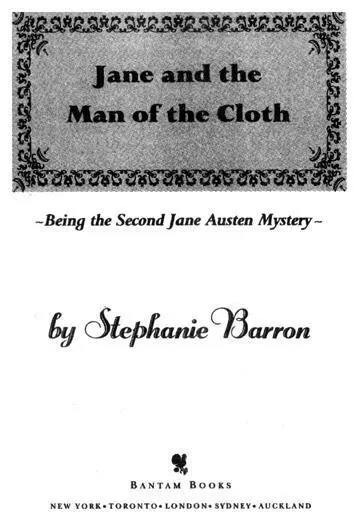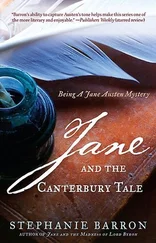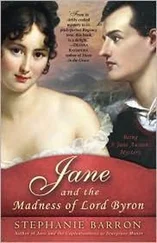Stephanie Barron - Jane and the Man of the Cloth
Здесь есть возможность читать онлайн «Stephanie Barron - Jane and the Man of the Cloth» весь текст электронной книги совершенно бесплатно (целиком полную версию без сокращений). В некоторых случаях можно слушать аудио, скачать через торрент в формате fb2 и присутствует краткое содержание. Жанр: Исторический детектив, Иронический детектив, на английском языке. Описание произведения, (предисловие) а так же отзывы посетителей доступны на портале библиотеки ЛибКат.
- Название:Jane and the Man of the Cloth
- Автор:
- Жанр:
- Год:неизвестен
- ISBN:нет данных
- Рейтинг книги:3 / 5. Голосов: 1
-
Избранное:Добавить в избранное
- Отзывы:
-
Ваша оценка:
- 60
- 1
- 2
- 3
- 4
- 5
Jane and the Man of the Cloth: краткое содержание, описание и аннотация
Предлагаем к чтению аннотацию, описание, краткое содержание или предисловие (зависит от того, что написал сам автор книги «Jane and the Man of the Cloth»). Если вы не нашли необходимую информацию о книге — напишите в комментариях, мы постараемся отыскать её.
Jane and the Man of the Cloth — читать онлайн бесплатно полную книгу (весь текст) целиком
Ниже представлен текст книги, разбитый по страницам. Система сохранения места последней прочитанной страницы, позволяет с удобством читать онлайн бесплатно книгу «Jane and the Man of the Cloth», без необходимости каждый раз заново искать на чём Вы остановились. Поставьте закладку, и сможете в любой момент перейти на страницу, на которой закончили чтение.
Интервал:
Закладка:
Stephanie Barron
Jane and the Man of the Cloth
Being the Second Jane Austen Mystery

Dedicated with love to my sister Cathy,
who always gave me the best books;
and to my sister Jo,
who taught me to read

Editor's foreword
When Jane Austen traveled to the Dorset coastal town of Lyme Regis in the late summer of 1804, she returned to a part of England she had first visited the previous year and that she is thought to have loved. She chose Lyme and its peculiar blend of fishermen, retired naval officers, and fashionable pleasure seekers for a pivotal passage in her final novel, Persuasion, published posthumously in 1818. Her affection for the town's steep streets and bracing Cobb (a stone breakwater encircling the harbor of the same name), the secretive wilderness called the Pinny and the high downs beyond, shines through the scenes she set down on paper over ten years after the action of this memoir.
For Jane and the Man of the Cloth is exactly that — a memoir of Austen's detective adventures in Lyme in the late summer of 1804. Austen scholars have long been frustrated by their lack of knowledge about this period in her life, since only one letter written from the town survives in the collected correspondence. In that lengthy note to Cassandra, Jane talks of many people and events that will become familiar to the reader of the present volume. We listen as she discusses Mr. Crawford, with whom she had danced the previous evening at the Thursday night Assembly; the servant-man James and his lanthorn; Miss Armstrong; the Schuylers and the Honourable Barnewalis—“bold, queer-looking people, just fit to be Quality at Lyme”—and the mysterious man she names only as Le Chevalier, who divided the winnings of a card game with her mother. The details are tantalizing, because they are fragmentary — and yet powerfully suggestive of the richness of the author's visit to the Dorset coast.
At long last, the full story of Jane's extraordinary Lyme experiences may be shared with the world, in the form of this diary account, one of many discovered among the long-lost Austen journals currently undergoing restoration and editing in the United States. [1] For a full account of the journals’ discovery, readers are directed to the Editor's Foreword in the first volume of the Austen collection, published by Bantam Books in May 1995 under the title of Jane and the Unpleasantness at Scargrave Manor.
Although the events Jane Austen describes in the following pages are surprising enough, it is possible that they serve to elucidate a personal episode in her life that has been the subject of much conjecture and debate. Years after Jane's death, Cassandra Austen, Jane's older sister and closest confidante, told her niece Caroline that the writer was involved in an unfortunate love affair with a clergyman whom she had met during a seaside holiday. The young man died or otherwise disappeared before an engagement could be formed, and since Cassandra was notoriously closemouthed regarding her sister's private life, neither the gendeman's name nor the exact history of the affair have come down to posterity. Various Austen family members recorded conflicting explanations of the episode — which Caroline Austen termed Jane's “nameless and dateless*’ romance — and the facts appear to have been garbled with time. It has been suggested that the clergyman's brother was a doctor, whom Cassandra visited years after Jane's death; or that the unknown suitor was in fact the Reverend Samuel Blackall, an acquaintance of Jane's for many years previous to this period. Constance Pilgrim, in her book Dear Jane: A Biographical Study of Jane Austen (Pentlands Press, Durham, 1971), goes so far as to suggest that the writer's mystery lover was Captain John Wordsworth, a naval officer and brother of the poet William Wordsworth, who was lost with his ship in 1805, and that they met in Lyme Regis as early as 1797—a theory described as “fanciful” by George Holbert Tucker, another Austen scholar. Some have asserted that Jane met the unknown clergyman while traveling with her family in Dorset during the summer of 1801; others place the encounter closer to 1804. [2] For an excellent survey of the “nameless and dateless” romance theories, as well as a rich portrait of Austen's milieu, see George Holbert Tucker, Jane Austen the Woman, St. Martin's Press, 1994.
Jane and the Man of the Cloth offers one possible answer to the debate. Austen's acquaintance with both Geoffrey Sidmouth, whom she believed to be the notorious Reverend, and Captain Percival Fielding — as well as Sidmouth's friendship with the medical doctor William Dagliesh, whom Cassandra knew and might well have visited in later years — make it likely that the writer's “nameless and dateless” romance occurred in Lyme in the late summer of 1804. To offer further evidence here would be to spoil the tale for the reader; so I shall allow Jane to speak for herself and leave it to the reader to determine the truth of matters.
In editing this volume, I found that Geoffrey Morley's 1983 work, Smuggling in Hampshire and Dorset: 1800—1850 (Newbury UK: Countryside Books), was very nearly indispensable. I would offer it to readers who wish to know more about Free Trade and the Gentlemen of the Night. Novelist John Fowles, who has lived and worked in Lyme for many years, is the author of A Short History of Lyme Regis (Little, Brown & Co., 1982), a concise but thorough summary of the town and its past.
STEPHANIE BARRON
EVERGREEN, COLORADO
Chapter 1
The Perils of Travelling Post
3 September 1804
at High Down Grange,
on the Lyme road
IT IS A TRUTH UNIVERSALLY ACKNOWLEDGED, THAT THE EXPECTATION of pleasure is generally preferred to its eventual attainment — the attainment being marred, at its close, by the resumption of quotidian routine made onerous by the very diversions so lately enjoyed. But as I gaze upon the tortured aspect of my dearest sister, her head bound round in a makeshift bandage, her pallor extreme, and her features overlaid with suffering, I must declare all such nice distinctions the indulgence of a frivolous mind. For how much more melancholy still, to find pleasure usurped entirely by the advent of disaster! To have no chance of mourning the end of good times, by observing them waylaid and truly routed before they had even begun! And Cassandra's is the sort of misfortune one never anticipates, being met in unhappy accident — the chance of a moment decided it; and the course of our long-awaited pleasure trip to Lyme is thrown utterly to the winds.
But I write entirely of outcomes, and am quite heedless of causes; a testament to the discomposure of my mind. I shall step back, the better to govern the tumult of my reason, and endure again the horror of those moments that left my dear one insensible in a stranger's bed.
BATH BEING UNBEARABLY HOT THIS AUGUST, AND MY FATHER'S health indifferent, we determined to exchange our rooms in Town for more salubrious ones along the coast. We had little inclination to try the bustle and vulgarity of Ramsgate [3] The Austens had visited Ramsgate during the spring or summer of 1803, prior to their first visit to Lyme that September. Jane disliked Ramsgate intensely; and when she wished to place a fictional charac ter in a compromising position, she often sent her to Ramsgate. Georgiana Darcy was nearly seduced by Wickham there, in Pride and Prejudice, while in Mansfield Park, Maria Bertram endured a loveless Ramsgate honeymoon before her adulterous affair with Henry Crawford. — Editor's note.
Интервал:
Закладка:
Похожие книги на «Jane and the Man of the Cloth»
Представляем Вашему вниманию похожие книги на «Jane and the Man of the Cloth» списком для выбора. Мы отобрали схожую по названию и смыслу литературу в надежде предоставить читателям больше вариантов отыскать новые, интересные, ещё непрочитанные произведения.
Обсуждение, отзывы о книге «Jane and the Man of the Cloth» и просто собственные мнения читателей. Оставьте ваши комментарии, напишите, что Вы думаете о произведении, его смысле или главных героях. Укажите что конкретно понравилось, а что нет, и почему Вы так считаете.












